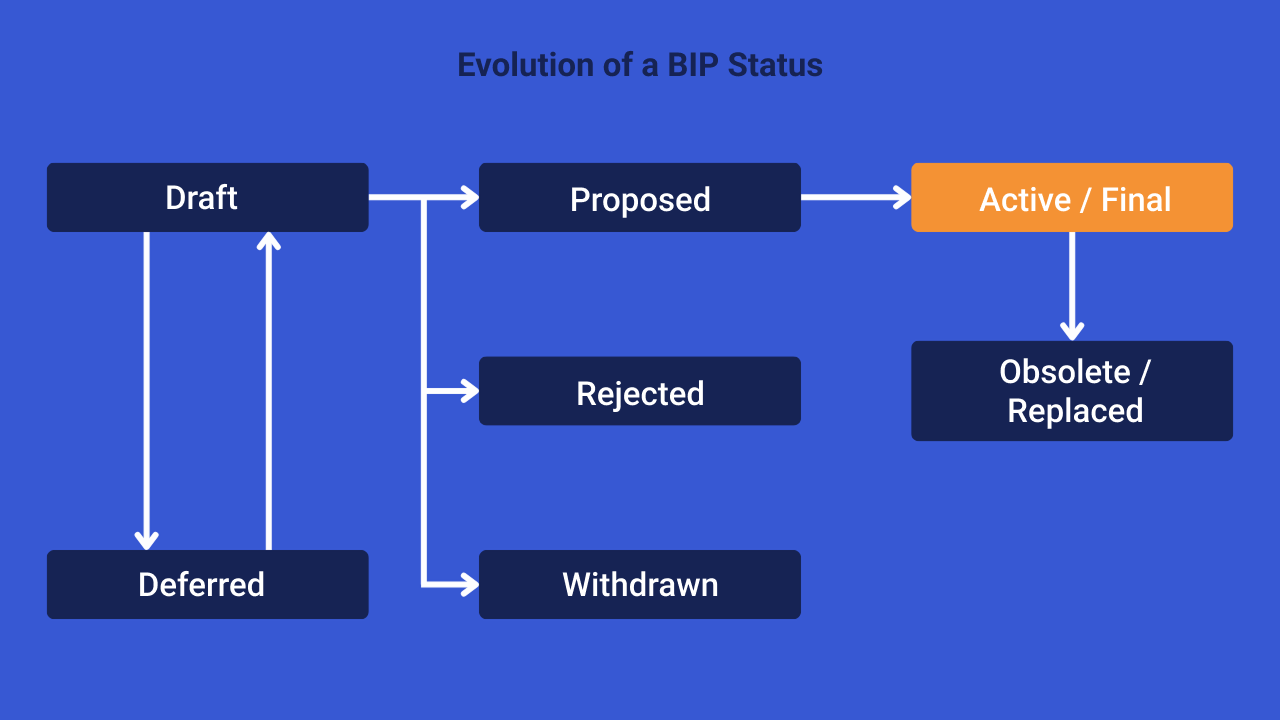Get started
Get started

Bitcoin does not have any central entity that can decide what updates to be made and how to evolve the protocol. However, it has been constantly evolving since 2009, so that the most recent implementations no longer have much in common with Satoshi Nakamoto's initial invention in terms of their code.
To prevent this evolution process from being chaotic, developers use the support of BIPs. These improvement proposals allow the community to suggest, discuss, and implement new features to optimize the Bitcoin protocol. But what exactly is a BIP, and how does this process work? In this article, we take an in-depth look at what a BIP is, the different types of proposals that exist, and the steps that can lead to the adoption of a BIP.
BIP is an acronym for” Bitcoin Improvement Proposal ”, which can be translated into French as “proposal to improve Bitcoin”. It is a formal document used to propose protocol changes, a new feature, or a new standard. The main objective of BIPs is to provide a framework for making changes on Bitcoin transparently, while maintaining existing consensus.
Each BIP is a detailed document that explains the objectives of the proposed improvement, the rationales behind it, any compatibility issues, and the pros and cons. It also details the technical steps required to implement the improvement.
BIPs can be written by anyone. However, they must be subject to the approval of other members of the Bitcoin community. The process is managed by Bitcoin Core, which makes up around 99% of the node network. Six developers are responsible for managing the BIPs: Bryan Bishop, Jon Atack, Jon Atack, Luke Dashjr, Mark Erhardt (Murch), Olaoluwa Osuntokun, and Ruben Somsen.
However, it is important to understand that the role of these individuals in editing BIPs does not mean that they control Bitcoin, however. If someone proposes an improvement that is not accepted within the formal framework of BIPs, they can always present it directly to the Bitcoin community, or even create a fork that includes modifying it. The advantage of the BIP process lies in its formality and centralization, which facilitate debate to avoid division among Bitcoin users, seeking to implement updates in a consensual manner. In the end, it is the principle of economic majority that determines the power games within the protocol.
BIPs are classified into three main categories: specification BIPs (Standards Track), informational BIPs (Informational) and process BEPs (Process).
Les Specification beeps concern changes that directly affect Bitcoin implementations. This category includes network changes, new validity rules for blocks and transactions, and interoperability aspects. It is in this category that we find major Bitcoin updates, such as the BIPs associated with the SegWit soft fork (BIP141, BIP143 and BIP147).
Les Informational BEPs provide information or recommendations to the Bitcoin community. Although they do not propose direct changes to the protocol, they provide advice on various operational aspects. For example, the BIP32, which introduced the deterministic and hierarchical wallets that are widely used today, is an informational BIP. It guides developers on a standard organization of cryptographic keys in a wallet without requiring software to follow this standard.
Finally, the Process beeps describe changes in the procedures surrounding Bitcoin that do not directly affect the protocol. These BIPs can relate to changes in governance processes or development tools, and are mainly used to structure how discussions are done. A typical example is BIP2, which defines how BIPs should be written.
Standard Track and informational BIPs, which make up the majority of proposals, are also classified by “Layer” or layer. This additional categorization specifies what aspect of the Bitcoin system is affected by the BIP. This allows you to know if the BIP will affect consensus rules, network communications, wallets, etc. Here are the different layers that exist:
➤ Discover the difference between a soft fork and a hard fork.
The process of creating a BIP starts with the conceptualization of an idea. The author of the BIP, often referred to as the “champion,” discusses his idea with the developer community via the mailing list Bitcoin-dev. This stage makes it possible to gather opinions and assess the relevance of the proposed idea.
If the idea is promising, the champion then proceeds to write the BIP document, respecting the format. Once written, the BIP is shared again with the mailing list Bitcoin-dev to refine the proposal. When the BIP is finalized, the author must then propose to add it to the GitHub repository that contains all the BIPs.
The editors of BIP are reviewing this proposal to see if it meets all the criteria. The BIP should be technically feasible, beneficial to the protocol, consistent with the required formatting, and consistent with Bitcoin's philosophy. If the BIP meets these conditions, it is officially integrated into the GitHub BIP repository. He will then be given a number. This number is decided by the editor, usually Luke Dashjr, and is assigned logically: BIPs dealing with similar topics often receive consecutive numbers.
BIPs go through different statuses during their life cycle. The current status is specified in the header of each BEP:

➤ Learn more about methods for activating forks on Bitcoin.
Les Bitcoin Improvement Proposals (BIPs) embody a process that is essential for the conflict-free evolution of Bitcoin. They allow the community to propose, discuss, and implement improvements in a transparent manner, while seeking consensus from users. They ensure that Satoshi Nakamoto's invention continues to advance without falling into chaos, despite its distributed structure.




